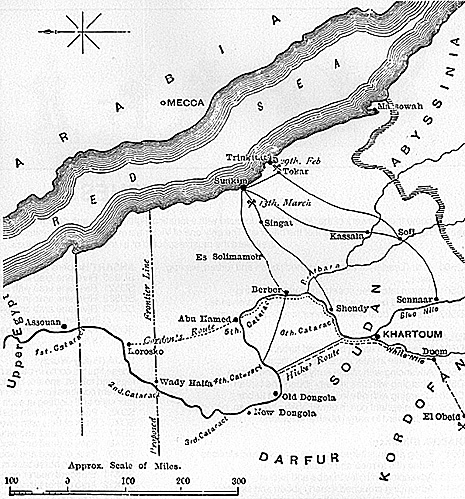If we 'adnt lost some messmates, we would 'elp you to deplore;
But give an' take's the gospel, an' we'll call the bargain fair,
For if you have lost more than us, you crumpled up the square!
-- Kipling
INTRODUCTION
With 6 miles covered beyond Suakim, it was decided to make camp, due to the extremely slow progress of the advance - 4 hours to cover 6 miles. The scrub (Mimosa Trees) was 6 to 8' high and t1w advance in 2 squares had been a nightmare of stops and starts with pack animals loosing their loads and causing the squares to constantly lose formation.
At 10.30am the new camp site was laid out, some 2 miles from the intended site. It was the intention to send the Indian Brigade back along with all the pack camels to a intermediate zeriba, 4 miles back towards Suakim.
This new site was a form of horseshoe, some 350 yards wide, with thick scrub all around. The Indian Brigade stood easy with fixed bayonets, the British troops piling their arms and either resting or constructing the zeribas.
The camels carrying water in mussacks were started to be emptie into some water tanks that had been brough along and place into the as yet unfinished central zeriba (see map).
Forces Engaged
British
Exact numbers of men in the Battalions ar difficult to find, but all appear to have been up to full strength - approximately 700 men in each.
Commander - General Sir John McNeill
British Brigade
- Berkshire Regiment
Royal Marine Light Infantry Batt.
Naval Brigade with 4 Gardner guns - 30 men
Detachment of Royal Engineers Cavalry - 1 squadron of the 5th Lancers
One further squadron of Hussars was patrolling back towards Suakim.
Indian Brigade
- 15th Sikh Batt.
28th Bombay Native Infantry
17th Bengal Native Infantry
1 company of the Madras Sappers
Baggage animals
- 580 camels with 11,500
gallons of water
500 camels carrying supplies
400 pack mules and assorted horses/camels carrying other baggage.
A total of 1,500 baggage animals, giving you a clear idea of the immense difficulty there must of been in controlling such a huge amount of animals, through such difficult terrain.
Mahdist Forces
Commander - Osman Digna
- 5-8,000 tribesmen.
The majority were infantry, although some camel-men were present.
Map of the Country between Egpt and the Sudan

More McNeill
-
McNeill's Zeriba: Introduction
McNeill's Zeriba: The Battle
McNeill's Zeriba: Battle Profile (Analysis) and Wargaming
Back to Colonial Conquest Issue 4 Table of Contents
Back to Colonial Conquest List of Issues
Back to MagWeb Master List of Magazines
© Copyright 1993 by Partizan Press.
This article appears in MagWeb (Magazine Web) on the Internet World Wide Web.
Other military history articles and gaming articles are available at http://www.magweb.com